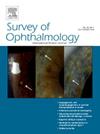Glaucoma in retinopathy of prematurity: A review
IF 5.9
2区 医学
Q1 OPHTHALMOLOGY
引用次数: 0
Abstract
Glaucoma in retinopathy of prematurity (ROP) is a challenge. It is typically secondary, though it may be associated with primary congenital glaucoma. Secondary causes are multifactorial, with mechanisms and severity potentially linked to the stage of ROP, time of presentation, or interventions for its treatment. Anecdotal reports of glaucoma following anti-vascular endothelial growth factor injection exist, but conclusive evidence is lacking. The most important cause of glaucoma in ROP is secondary angle closure in patients with stage 5 ROP. Clinical features such as corneal clouding and increased corneal diameters are clues to diagnosing glaucoma; however, glaucoma may present much later in life as well, therefore, life-long follow-up of these patients is essential. Appropriate control of intraocular pressure (IOP) becomes imperative in infants with ROP as these eyes tend to enlarge quickly with raised IOP. Management strategies consist of medical therapy, angle-based surgery, filtration surgery, glaucoma drainage devices and cyclo-ablation. The choice of therapy is individualized according to the age, presentation of glaucoma, and visual potential. We review the epidemiology, etiology, natural history, risk factors, clinical features, investigations, differential diagnosis, management and outcomes of glaucoma in ROP.
早产儿视网膜病变青光眼的研究进展。
青光眼在早产儿视网膜病变(ROP)是一个挑战。它通常是继发性的,尽管它可能与原发性先天性青光眼有关。继发原因是多因素的,其机制和严重程度可能与ROP的阶段、出现时间或治疗干预措施有关。抗血管内皮生长因子注射后青光眼的轶事报道存在,但缺乏确凿的证据。第5期ROP患者继发闭角是导致ROP青光眼的最重要原因。临床表现如角膜混浊、角膜直径增大是诊断青光眼的线索;然而,青光眼也可能在生命的后期出现,因此,对这些患者进行终身随访是必要的。眼内压(IOP)的适当控制对ROP婴儿来说是必要的,因为这些眼睛往往随着IOP的升高而迅速增大。治疗策略包括药物治疗、角度手术、滤过手术、青光眼引流装置和循环消融。治疗的选择是根据年龄、青光眼的表现和视觉潜能进行个体化的。我们综述了ROP青光眼的流行病学、病因学、自然病史、危险因素、临床特征、调查、鉴别诊断、治疗和结局。
本文章由计算机程序翻译,如有差异,请以英文原文为准。
求助全文
约1分钟内获得全文
求助全文
来源期刊

Survey of ophthalmology
医学-眼科学
CiteScore
10.30
自引率
2.00%
发文量
138
审稿时长
14.8 weeks
期刊介绍:
Survey of Ophthalmology is a clinically oriented review journal designed to keep ophthalmologists up to date. Comprehensive major review articles, written by experts and stringently refereed, integrate the literature on subjects selected for their clinical importance. Survey also includes feature articles, section reviews, book reviews, and abstracts.
 求助内容:
求助内容: 应助结果提醒方式:
应助结果提醒方式:


